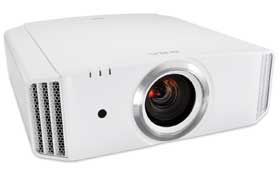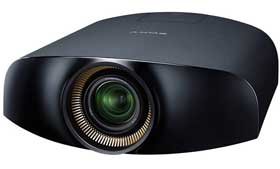About LCoS
There are several variations of this technology in use today. This technology generically uses a reflective layer placed behind a liquid crystal layer and as a result these micro-display panels work by reflecting light rather than being transmissive. Another difference, as compared to conventional LCD technology, is in conventional LCD transmissive displays the electronics controlling each pixel are located between the pixels, while with LCoS the electronics that control each pixel located on the same chip behind that pixel. This allows the pixels to be positioned with less gap between the adjacent pixels resulting in projected images with a substantially higher “fill factor” with LCoS based projectors than with 3LCD projectors. LCoS projectors are generally noted from their smooth ‘film like’ projected images while images from 3LCD projector may exhibit a more noticeable ‘screen door effect’ when seen from moderately close viewing distances.
Some of the projector manufacturers use their own trademarked names to describe their variation of LCoS technology. JVC calls their variation “Direct Drive Image Light Amplifier” (D-ILATM), Sony calls their variation “Silicon Xtal Reflective Display” (SXRDTM) and Epson has demonstrated a variation called “LCD-ReflectiveTM”. Canon also offers business-class projectors where they use the more generic term “LCoS”.
Early generations of LCoS projectors offered black levels and contrast ratios that were generally only a little superior, to LCD projectors of that same era, but those early LCoS models generally trailed behind the performance of the best DLP projectors for those characteristics. However, the current generation of home theater LCoS based projectors from Sony and especially JVC excel in leading the industry for these desirable characteristics.
LCoS Pricing
The current generation of LCoS based home theater projectors are generally being sold with street prices between $3,000 and $10,000 and offer a native resolution of 1080p (1920 x 1080 pixels). JVC and Sony both offer 1080p home theater projectors with prices for the JVC D-ILA projectors starting at $3,499 (MSRP), for the JVC DLA-X35 or the virtually identical model DLA-RS46, and Sony offers their model VPL-HW50ES for $3,999 (MSRP).
 Click Image to Enlarge
Click Image to EnlargeLCoS Performance
Today, LCoS technology, is arguably the best of the three digital projection technologies in the under $10,000 home theater projector arena. Certainly, LCoS projectors aren't the cheapest, with virtually all models offering 1080p native resolution at prices of $3,000 and up, so LCoS is definitely not competing against DLP and LCD based projectors in the low-end 720p or entry-level 1080p marketplace.
In 2012 Sony became the first manufacture to begin shipping a consumer-class home theater projector with native 4K Ultra High Definition resolution (4096 x 2160 in the case of this model). The Sony VPL-VW1000ES (pictured), when introduced, carried a list price of $25,000 and offered state-of-the-art performance for a home theater class projector.
 Click Image to Enlarge
Click Image to EnlargeCanon offers business class LCoS projectors with up to WUXGA native resolution (1920 x 1200 pixels and a 16 x 10 aspect ratio) including the Canon REALiS WUX4000 (MSRP $7499) and with other LCoS based business models in their REALiS product line starting at under $4,000 (MSRP). Sony offers SXRD based business class projectors including a high-end professional version of the 4K UHD model at a list price of under $50,000. Also Sony is the leading supplier of 4K commercial LCoS projectors for the digital cinema industry.



